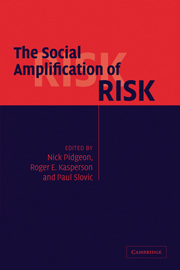Book contents
- Frontmatter
- Contents
- List of figures
- List of tables
- List of contributors
- Acknowledgments
- Introduction
- Part I Conceptual foundations
- Part II Risk signals and the mass media
- Part III Public perceptions and social controversy
- Part IV Risk ripples and stigma effects
- 13 Integrating politics with the social amplification of risk framework: insights from an exploration in the criminal justice context
- 14 Nuclear stigma
- Part V Policy and management
- Bibliography
- Index
13 - Integrating politics with the social amplification of risk framework: insights from an exploration in the criminal justice context
Published online by Cambridge University Press: 06 July 2010
- Frontmatter
- Contents
- List of figures
- List of tables
- List of contributors
- Acknowledgments
- Introduction
- Part I Conceptual foundations
- Part II Risk signals and the mass media
- Part III Public perceptions and social controversy
- Part IV Risk ripples and stigma effects
- 13 Integrating politics with the social amplification of risk framework: insights from an exploration in the criminal justice context
- 14 Nuclear stigma
- Part V Policy and management
- Bibliography
- Index
Summary
Some risk-related incidents have far-reaching societal impacts while others gradually fade from public attention and memory. These societal impacts include direct policy responses such as stricter regulation of the relevant risk and also “significant indirect impacts such as liability, insurance costs, loss of confidence in institutions, stigmatization, or alienation from community affairs” (Kasperson 1992, p. 158). Paradoxically, the magnitude of such societal impacts often has little to do with the technically assessed magnitude of the actual risks involved. Attempts to explain this puzzle resulted in the development of the social amplification of risk framework (SARF) (Kasperson, Renn, Slovic et al. 1988).
The developers of the SARF have argued that amplification and attenuation depend on a complex set of behavioral, psychological, social, and cultural processes, rather than objective measures of risk. Factors affecting social amplification include public concern and fears about the risks and attention from the media and active opposition from key individuals and groups in society. While the SARF clearly makes a substantial contribution to our understanding of why the social amplification of risks occurs, it has not yet arrived at a clearly developed understanding of how some risk-related incidents get attenuated rather than amplified. The developers of the SARF clearly recognize this problem and are actively exploring different hypotheses to enhance our understanding of attenuation. For example, Kasperson has asked whether “individual components of social amplification processes have a ‘necessary but not sufficient quality,’ that multiple elements of social amplification must be present if the process is to ‘take off’ and to be sustained?” (Kasperson 1992, p. 174).
- Type
- Chapter
- Information
- The Social Amplification of Risk , pp. 305 - 325Publisher: Cambridge University PressPrint publication year: 2003
- 3
- Cited by

